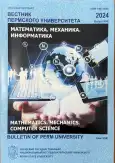Numerical Analysis of Natural Frequencies of Three-layer Plate under Temperature Load
- Autores: Kamenskikh A.O.1
-
Afiliações:
- Institute of Continuous Media Mechanics Ural Branch of the Russian Academy of Sciences
- Edição: Nº 3 (66) (2024)
- Páginas: 23-34
- Seção: Mechanics
- URL: https://journal-vniispk.ru/1993-0550/article/view/307280
- DOI: https://doi.org/10.17072/1993%20-0550%20-2024%20-3-23-34
- ID: 307280
Citar
Texto integral
Resumo
One of the options for controlling the dynamic state of thin-walled structures is the creation of prestress state within. Stress field can be induced by various actuators, smart materials or plastic deformation. Deformations arising from uneven temperature distribution, different coefficient of thermal expansion of the materials or boundary conditions also affect the natural frequencies. This can lead to undesirable phenomena such as loss of stability or spectrum moving into the region of frequencies subject to resonance. In this paper, the influence of temperature loading on the natural frequencies of a three-layer plate is investigated by the finite element method. The obtained solution of the spectral problem is compared with the results of other authors. Plates with different configurations and boundary conditions are considered. The relative change of the plate first three natural frequencies on temperature load are received. It is shown that the resulting prestressed state has poor effect on natural frequencies free-edges plate. The results of numerical calculations for a plate clamped on both sides demonstrate that with increasing stiffness, the critical temperatures also increase.
Palavras-chave
Sobre autores
A. Kamenskikh
Institute of Continuous Media Mechanics Ural Branch of the Russian Academy of Sciences
Autor responsável pela correspondência
Email: kamenskikh.a@icmm.ru
Junior Researcher 1, Academican Korolev St., Perm, Russia, 614018
Bibliografia
- Pradeep, V., Ganesan, N. and Bhaskar, K. (2007), "Vibration and thermal buckling of composite sandwich beams with viscoelastic core", Compos. Struct., vol. 81, no. 1, pp. 60–69.
- Prokudin, O.A. et al. (2020), "Dynamic characteristics of three-layer beams with load-bearing layers made of alumino-glass plastic", PNRPU Mech. Bull., vol. 2020, no. 4, pp. 260–270.
- Meyers, C.A. and Hyer, M.W. (1991), "Thermal buckling and postbuckling of symmet-rically laminated composite plates", J. Therm. Stress., vol. 14, no. 4, pp. 519–540.
- Prabhu, M.R. and Dhanaraj, R. (1994), "Thermal buckling of laminated composite plates", Comput. Struct., vol. 53, no. 5, pp. 1193–1204.
- Chen, L.W. and Chen, L.Y. (1987), "Thermal buckling of laminated composite plates", J. Therm. Stress., vol. 10, no. 4, pp. 345–356.
- Azzara, R., Carrera, E. and Pagani, A. (2022), "Nonlinear and linearized vibration anal-ysis of plates and shells subjected to compressive loading", Int. J. Non. Linear. Mech., vol. 141, pp. 103936.
- Álvarez, J.G. and Bisagni, C. (2021), "A study on thermal buckling and mode jumping of metallic and composite plates", Aerospace, vol. 8, no. 2, pp. 1–17.
- Tong, B. et al. (2024), "Free vibration analysis of fiber-reinforced composite multilayer cylindrical shells under hydrostatic pressure", J. Sound Vib., vol. 587, pp. 118511.
- Kuo, S.Y. (2016), "Flutter of thermally buckled angle-ply laminates with variable fiber spacing", Compos. Part B Eng., vol. 95, pp. 240–251.
- Bochkarev, S.A., Lekomtsev, S.V. and Matveenko V.P. (2015), "Natural vibrations and stability of functionally graded cylindrical shells under mechanical and thermal loads", Mekhanika kompozicionny`kh materialov i konstrukcij, vol. 21, no. 2, pp. 206–220. (In Russian)
- Bochkarev, S.A. and Lekomtsev, S.V. (2015), "Natural vibrations of heated functionally graded cylindrical shells with fluid", PNRPU Mech. Bull., vol. 2015, no. 4, pp. 19–35.
- Bochkarev, S.A., Lekomtsev, S.V. and Matveenko, V.P. (2016), "Hydrothermoelastic Stability of Functionally Graded Circular Cylindrical Shells Containing a Fluid", Mech. Compos. Mater., vol. 52, no. 4, pp. 507–520.
- Azzara, R. et al. (2023), "Vibration analysis of thermally loaded isotropic and composite beam and plate structures", J. Therm. Stress., vol. 46, no. 5, pp. 369–386.
- Champneys, A.R. et al. (2019), "Happy Catastrophe: Recent Progress in Analysis and Exploitation of Elastic Instability", Front. Appl. Math. Stat., vol. 5, pp. 1–30.
- Reis, P.M. (2015), "A Perspective on the Revival of Structural (In) Stability With Novel Opportunities for Function: From Buckliphobia to Buckliphilia", J. Appl. Mech. Trans. ASME, vol. 82, no. 11, pp. 1–4.
- Zienkiewicz, O.C. and Cheung, Y.K. (1967), "The Finite Element Method in Structural and Soild Mechanics".
Arquivos suplementares









